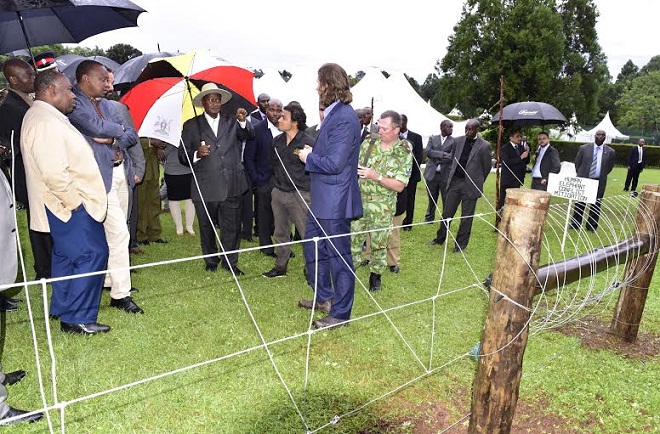
The UWA officials say that while the fence is not constructed to prevent people from crossing, it will help to demarcate the park’s boundary more clearly and assist park rangers in enforcing security and illegal harvesting of resources from the park, including poaching.
Njenga says the fence is effective on bigger animals like elephants, rhinos and buffaloes.
Space for Giants, a Nairobi-based conservation agency is building the initial 10km of fence on the eastern fringes of Queen Elizabeth National Park, from Kyezazza near the small township of Kyambura, near the Kyambura Gorge, to Kyabakara—a stretch of close to 10km. Each kilometre has cost the agency US$ 6000.
Edward Asalu, the Chief Warden of Queen Elizabeth Conservation Area told The Independent that UWA’s plan is to erect an electric fence stretching over 100km from the cobalt plant at KCCL through Muhokya and Kikorongo towards Bwera up to Busunga where the park ends.
“We have started with 10km as a pilot project to see how effective it can be but from the reports I am getting, the results are looking good.”
The electric fence will only be erected in what Asalu calls hotspot areas—places where the feud between elephants and people has been going on for decades. Asalu says these areas include Kyezazza, Rutoma and Kakari while on the Kasese side; the Kicwamba area is quite problematic.
Julius Nabasa, a Ugandan supervisor of the team constructing the fence told The Independent that the electric fence has brought almost instant results.
He says the elephants had a particular course along which they would move and cross and destroy people’s gardens but that has stopped.
Valley of death
The fence is being built at a time when confrontation between man and animals from the park has become increasingly fatal. Just four months ago, in September, Kwatampora woke up to the horror of his neighbour, Angelo Ndyoburungi’s death.
On the fateful day, he says, Ndyoburungi woke up to go to his farm but before he could start work, he was ambushed and gored by a buffalo. Gladys Muhindo, the deceased’s daughter in law told The Independent that although residents tried to save his life by rushing him to the nearby dispensary, he died from his injuries. He left seven children. His grave is just metres away from his mud and wattle house.
The horror of wild animals killing human beings does not stop in Kafuru. In the nearby Masoro village, the Kafuru residents say two people were recently killed by wild animals.
Such tales of desperation in this village might be anecdotal but they reflect the ever growing dangerous interaction between farmers and wild animals as both human and animal population swell.
Kwatampora told The Independent that the confrontations with the wild animals seem more these days than 40 years ago. He says back then it was only warthogs that occasionally crossed into their gardens and burrowed into their cassava and potato gardens. The elephant and buffalo attacks started around the 1990s, he says.
Olivia Biira, the community conservation manager for Queen Elizabeth National Park told The Independent that the problem of elephants’ havoc has been a long standing challenge.
She says cases of crop and property destruction, injuries, and even deaths are reported to her often and they strain relationships with some communities.
Asalu says the population of both elephants and human beings around the park has been increasing and that means that the human-wildlife conflict can only grow. He says a recent airborne survey found close to 4000 elephants in the park.
“All around the park, we have a hard time controlling elephants,” he says, adding that UWA has in the past had even its own staff get killed during missions to scare away the elephants from the communities.
Even President Yoweri Museveni has voiced his concern about the growing human-wildlife conflict around Uganda’s conservation areas. Museveni is a founding member of the Giants Club, a conservation programme that brings together political leaders, financiers, and scientists to endorse, fund, and implement elephant landscape protection projects. At a summit organized in Kenya in 2016, he called for a solution to the growing human-elephant conflict in Uganda.
Mending fences
Erecting the 10km electric fence is planned to be completed by the end of April. That is when its full effectiveness will be tested.
Asalu, the chief warden says UWA has in the past come up with several interventions such as bee farming (bees irritate elephants) as well as digging trenches in the park’s hotspots to try to stop elephants from going into the communities. All these have come with little success, sometimes owing to the high intelligence of the elephants.
When the trenches were dug, for instance, the elephants quickly got around this challenge by filling up the trenches with soil. Meanwhile other crossing areas were marshy swampland and the trenches could not be dug. The elephants soon saw these spots as good crossing points to the community gardens.
“We realized that these interventions were not adequate enough to handle this problem,” Asalu says to explain why success of the electric fence is critical.
But in other African countries where similar fences have been deployed, some people who live near fences break them in order to continue illegally entering the park to collect firewood or water or even poach bush meat. This sometimes renders the fence ineffective and elephants learn fast where fences are no longer electrified and take advantage. There must be strong local appreciation of the benefits the fence brings. The fence must also be maintained where it is damaged, to keep it effective.
Biira told The Independent that she hopes the electric fence will not only reduce damage to people’s property but also mend the relationship between the park managers and the communities.
****
 The Independent Uganda: You get the Truth we Pay the Price
The Independent Uganda: You get the Truth we Pay the Price



